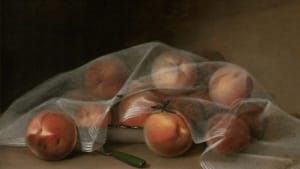Stay in the Loop
BSR publishes on a weekly schedule, with an email newsletter every Wednesday and Thursday morning. There’s no paywall, and subscribing is always free.
Portraying a new nation through its objects
Audubon to Warhol: The Art of the American Still Life

Academicians during the Renaissance created the hierarchy of genres and placed still lifes at the bottom, where they remained at least until the 19th century. Genres and approaches got shaken up then — who wouldn’t be happy to contemplate one of van Gogh’s vases of flowers? — but even today, a still life is mostly about the arrangement of the objects and the virtuosity of the artist. As such, it’s an academic exercise of interest primarily to interior decorators and, perhaps, other artists.
Curators thus face a special challenge in putting together a show that will not only honor the genre but also engage viewers; the curators of the Philadelphia Museum of Art’s Audubon to Warhol: The Art of the American Still Life have succeeded on both points. This lively, well-thought-out exhibit successfully makes the case that the new nation put its own twist on the still life and that Philadelphia was an important location for several chapters in that story.
Arranging selections chronologically — yes, the exhibit literally takes the viewer from Audubon in the first room to Warhol in the last — illuminates both American history and art history. In the early period of the republic, artists were involved in the wider effort to define America (for instance, by portraying its wildlife, as Audubon did) and to develop a distinctively American style of art (as, for instance, Philadelphia’s Peale, well represented in the show, did).
The downside of the chronological approach, of course, is that some connections can get lost. I was struck by Audubon’s painting of a squirrel, which looked very much like something Andrew Wyeth might have painted. (I eschewed the audio tour, so don’t know if I get art aficionado points for noticing that.) Similarly, my companion was struck by the similarity between Robert Spear Dunning’s 19th-century painting of a silver bowl, which shows the artist’s almost-empty studio in the bowl’s reflection, and (Philly-born, PAFA-trained) Charles Sheeler’s 1931 Cactus, which shows the lights and equipment of the artist’s photographic studio.
An inclusive definition
The show benefits from including artists who aren’t big names and defining “American still life” fairly loosely. A work by self-taught artist Robert S. Duncanson, an African American active before and during the Civil War, is hung next to a larger, more elaborate contemporary iteration, creating a strong but subtle political commentary about access not just to training, but to the luxury goods often portrayed in a still life. Amateur artists are represented by a large, beautifully detailed quilt and several oils of the late 19th century. The looseness of the use of the term “still life” becomes even more marked with the 20th-century works in the exhibit, which include a Calder stabile, the PMA’s version of Duchamp’s Fountain, and, of course, the titular Warhol of the show, his 1964 Brillo Boxes.
Should sculptures be considered examples of still life? Should ornithological paintings? Well, yeah, if you want to have a catchy title like “Audubon to Warhol,” but probably not otherwise. Did I feel like the victim of a bait and switch? Not in the least — the art was well chosen, well displayed, and well described. The curators could probably have gotten away with a less extensive sidetrack into trompe l’oeil, but otherwise the choices reflect the relative importance of the show’s themes and subthemes well. I was also delighted by the inclusion of several works I wouldn't have expected to see in the show and quite a few that I was unfamiliar with. (No spoilers — go see for yourself!)
Author’s note: I recommend John James Audubon: The Making of an American by Richard Rhodes if you find yourself curious to learn more about Audubon, both as artist and as man.
What, When, Where
Audubon to Warhol: The Art of the American Still Life. Through January 10, 2016 at the Philadelphia Museum of Art, 2600 Benjamin Franklin Parkway, Philadelphia. 215-763-8100 or philamuseum.org.
Sign up for our newsletter
All of the week's new articles, all in one place. Sign up for the free weekly BSR newsletters, and don't miss a conversation.

 Judy Weightman
Judy Weightman